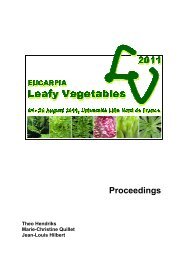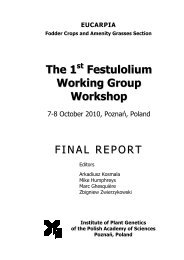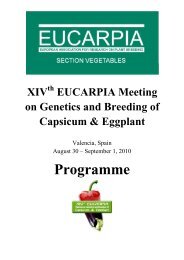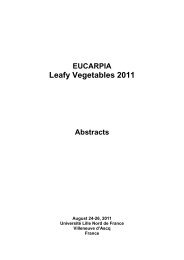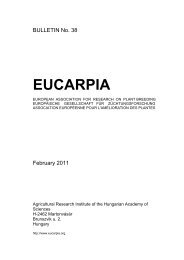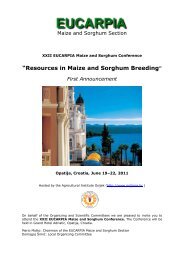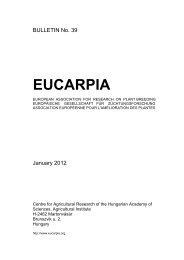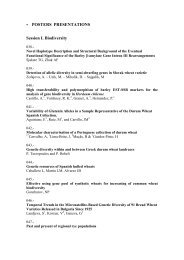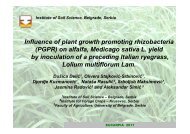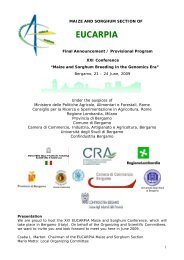Plant breeding for organic and sustainable, low-input agriculture
Plant breeding for organic and sustainable, low-input agriculture
Plant breeding for organic and sustainable, low-input agriculture
You also want an ePaper? Increase the reach of your titles
YUMPU automatically turns print PDFs into web optimized ePapers that Google loves.
Utilisation of spelt <strong>and</strong> emmer wheat genetic resources as cultivars in <strong>organic</strong><br />
farming<br />
Zdeněk Stehno 1 , Petr Konvalina 2 , Ladislav Dotlačil 1 , Jan Moudrý 2 ,<br />
1 Division of Genetics, <strong>Plant</strong> Breeding <strong>and</strong> Product Quality, Crop Research Institute, Ruzyně,<br />
Czech Republic; 2 Department of Agroecology, Faculty of Agriculture, University of South<br />
Bohemia, České Budějovice, Czech Republic<br />
With the aim to extend the spectra of grown crops mainly <strong>for</strong> <strong>organic</strong> farming, a collection of<br />
spelt <strong>and</strong> emmer genetic resources in the Czech Gene Bank was screened <strong>and</strong> some promising<br />
genotypes were selected. We focused on spelt wheat (Triticum spelta L.) because it is a<br />
traditional crop grown mainly in the North - West European countries. Interest in this crop in the<br />
Czech Republic is still increasing remarkably since 1990. Emmer wheat (T. dicoccon Schrank)<br />
has very long tradition in its growing <strong>and</strong> use in human nutrition. In the place of present Czech<br />
Republic it was important crop till ingress of Slavs in 6 th century A.D. when it was replaced by<br />
bread wheat. In spite of its considerable importance it was not much bred <strong>and</strong> at present there are<br />
only l<strong>and</strong>races <strong>and</strong> wild <strong>for</strong>ms of this species available.<br />
Spelt wheat has been collected as part of wheat collection of genetic resources. At present the<br />
collection contains 77 accessions of Triticum spelta L. <strong>and</strong> most of them (38) come under var.<br />
duhamelianum. Within the collection, the genotype 01C01-00670 (‘Fuggers Babenhauser<br />
Zuchtweizen’) showed very high protein content. Repeated individual selection was used to<br />
improve lodging resistance <strong>and</strong> stabilised high protein content. In 2001 material was registered<br />
as ‘Rubiota’ cultivar. Among genetic resources of emmer wheat (114 accessions), the genotype<br />
01C02-00948 appeared to be very perspective. Material later in ripeness, with good level of<br />
resistance to fungal diseases <strong>and</strong> with high yield potential among genotypes of this species was<br />
selected by bulk selection from this genetic resource. After three-year testing (DUS), it gained<br />
certificate of legal protection as cultivar ‘Rudico’.<br />
Winter spelt wheat ‘Rubiota’ has big grain with TKW reaching 60 g or more, which are not<br />
released from spikelets as easily as in second registered spelt cultivar in CR, ‘Franckenkorn’.<br />
Proportion of glumes in harvest varies between 23 <strong>and</strong> 25 %. Crude protein content (19.19 % in<br />
2002) is usually 1.5 - 2 % higher then in ‘Franckenkorn’. The cultivar is relatively susceptible to<br />
powdery mildew. Yield of naked grain in official test (UKZUZ, 2006) was 4.32 t/ha. Emmer<br />
wheat ‘Rudico’ has proportion of glumes in harvested spikelets ranging closely around 20 %. It<br />
is resistant to most of fungal diseases as powdery mildew, Pyranophora, Septoria tritici,<br />
Septoria nodorum. In resistance to these diseases, it exceeds registered spring bread wheat<br />
cultivars. Its resistance to Fusarium is medium. Among quality parameters, high crude protein<br />
content (19 – 20 %) <strong>and</strong> gluten content approx. 45 % are important ones. Values of SDS<br />
sedimentation test ranges between 35 <strong>and</strong> 40 ml. Grain yield is in comparison with other emmer<br />
genotypes very high <strong>and</strong> reaches under favorable conditions 3 t/ha; in plot experiment in 1998<br />
even 4.38 t naked grain per hectare. Maintance <strong>breeding</strong> of both cultivars which is in progress in<br />
the Crop Research Institute <strong>and</strong> ensured seed groving under <strong>organic</strong> system create favourable<br />
conditions <strong>for</strong> their successful utilization. That extends possibility to use spelt <strong>and</strong> emmer wheat<br />
<strong>for</strong> production of bio-food.<br />
Acknowledgement: Supported by the Research Plan MZE ČR 0002700602.<br />
63




